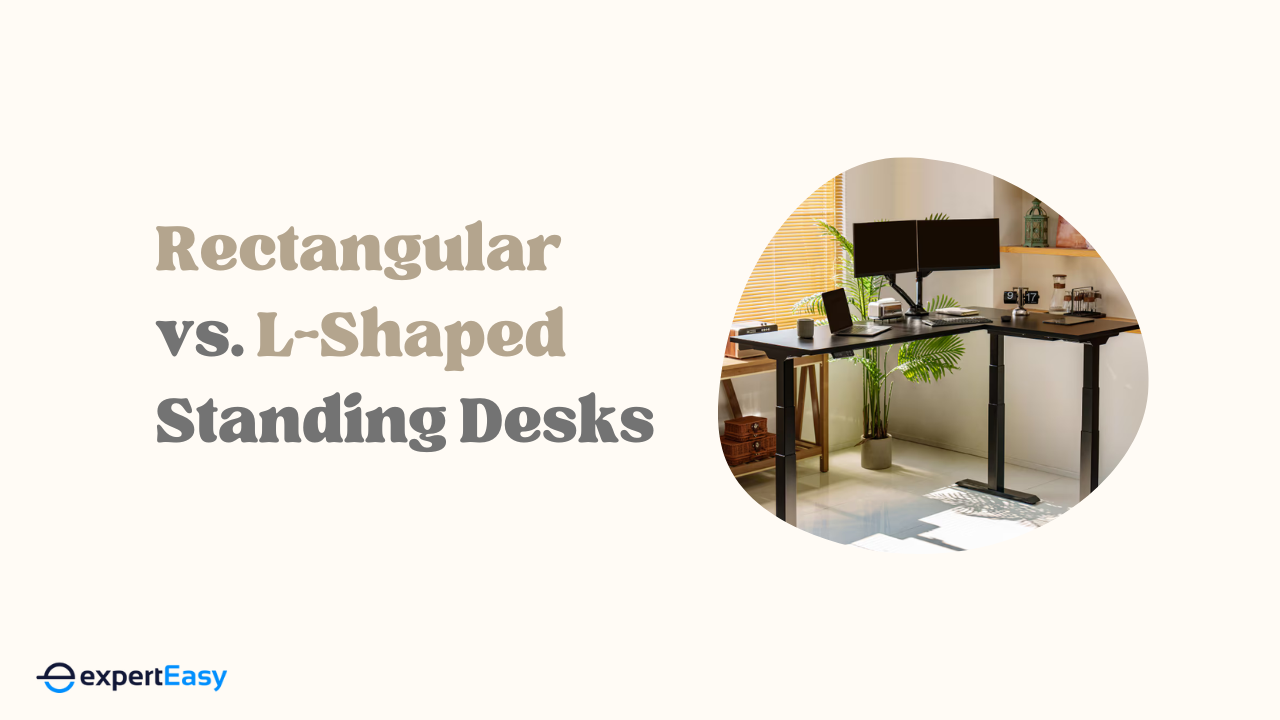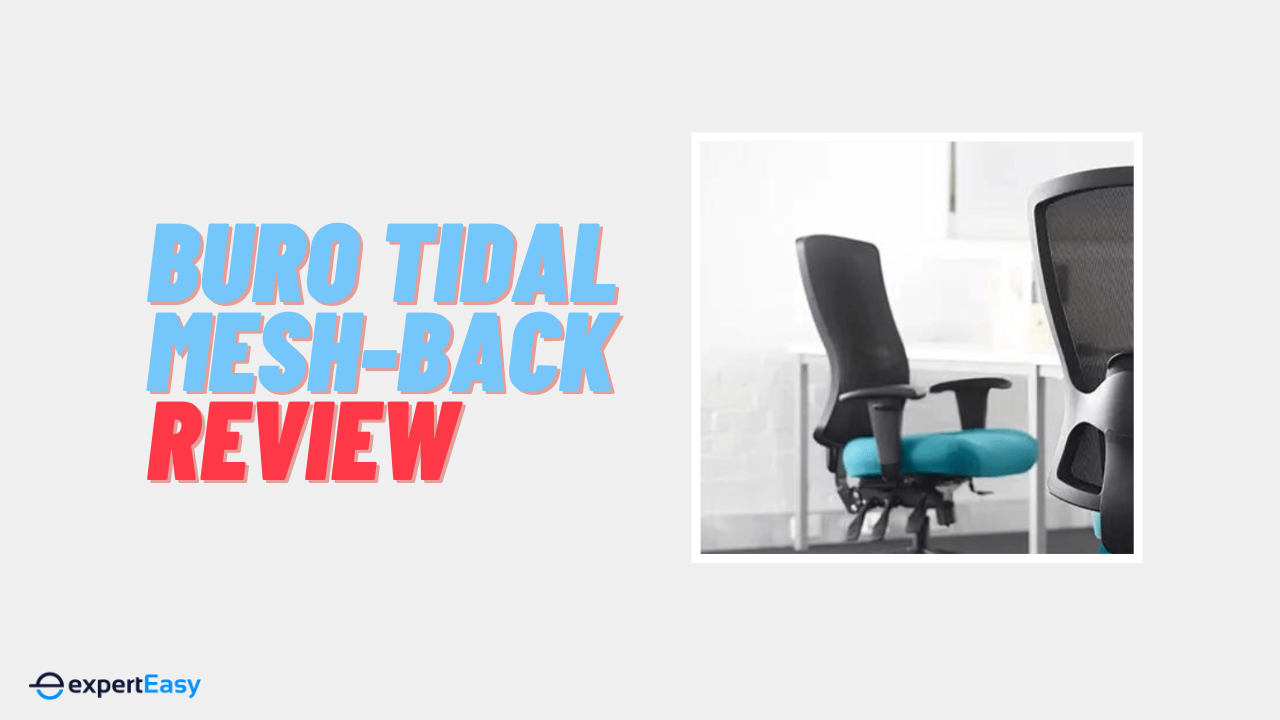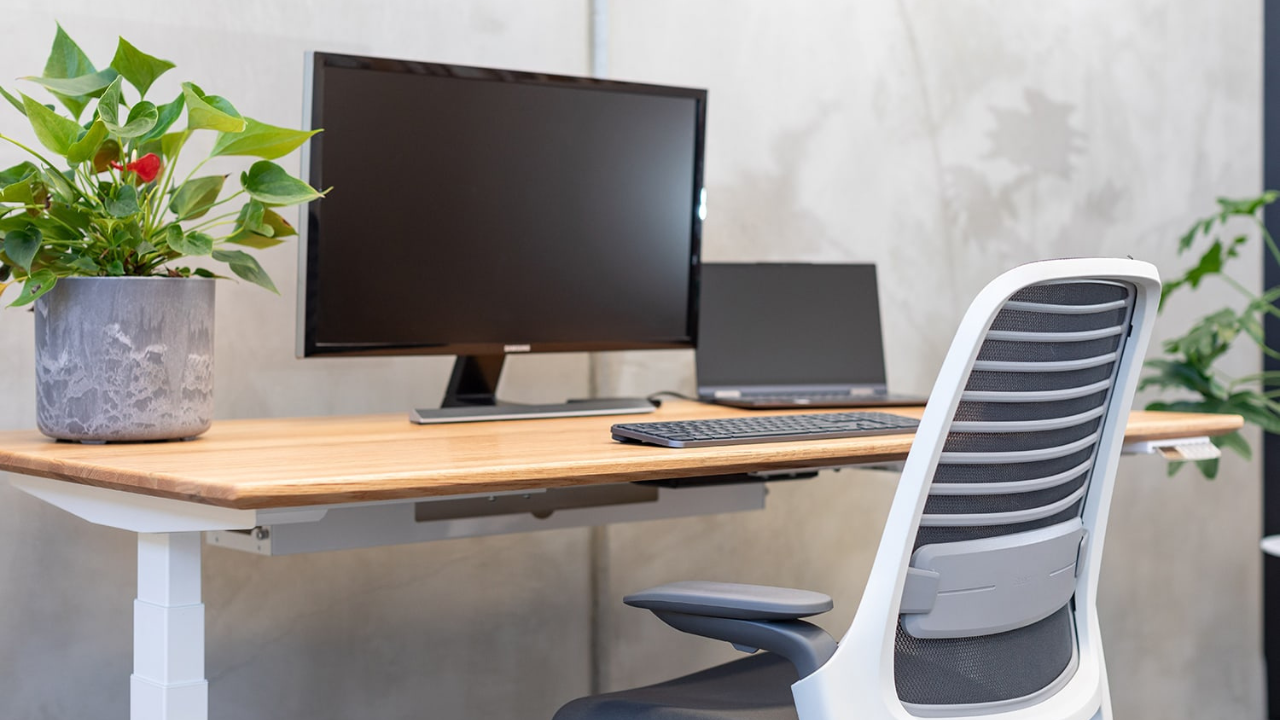There are many standing desk shapes to choose from, making what should be a simple decision somewhat daunting. The most common options among them are rectangular and L-shaped standing desks.
In this article, I’ll explain the differences between these two types of sit-stand desks and help you decide which best maximises your space, improves ergonomics, and matches your style. Let’s dive in.
What is a Rectangular Standing Desk?

A rectangular standing desk has a flat surface to work on while standing. They are popular in offices and home workspaces due to their ease of use and affordable price point compared to other desk shapes.
Some rectangular standing desks include built-in cable management, storage options, and electronic controls that let you adjust the desk's height with a button push. They can also be manual-adjustable sit-stand desks that require effort to adjust using a crank or lever.
Pros of a Rectangular Desk
Here are the benefits of using a rectangular standing desk:
- Fits a variety of room layouts
- Simpler mechanisms for height adjustment
- Beneficial for smaller rooms or offices
- Straightforward design for ease of use
- Often less expensive
Cons of a Rectangular Desk
For cons, rectangular standing desks often have:
- Limited surface area compared to L-shaped desks
- Fewer storage options
What is an L-Shaped Standing Desk?

An L-shaped standing desk has two connected surfaces forming an "L" shape. This design provides more workspace for your computer, documents, and accessories. Like other sit-stand desks, you can adjust it to an ideal height for better health outcomes. These desks are popular in shared workspaces and offices to foster collaboration and improve organisation.
L-shaped desks, like rectangular standing desks, can have a manual or electric lifting mechanism. You can also convert some L-shaped desks into simple, rectangular, sit-stand desks.
Pros of an L-Shaped Desk
For L-Shaped Standing Desks, you get:
- More surface or desktop area
- Better organisation with less clutter
- Ergonomic flexibility to easily switch between tasks
- Multi-functional use purposes
Cons of an L-Shaped Desk
It’s not all rosy; L-shaped standing desks have downsides.
- Complicated to set up and adjust
- More expensive than rectangular standing desks
- L-shaped desks take up more room
- Do not fit well in all room layouts
- Heavier and less portable
What Are the Differences Between Rectangular vs. L-Shaped Standing Desks?
You must understand each shape's distinct features and advantages to choose between a rectangular and an L-shaped standing desk. Here’s a breakdown of the three key differences:
#1 - Functionality and use cases
Rectangular standing desks are best for simpler setups, such as single or dual monitors, laptops, and minimal accessories. You can also easily reach across the desktop or surface without moving much, making them portable for limited space.
On the other hand, L-shaped standing desks best suit complex setups, including multiple monitors, printers, and other office equipment. They allow for better separation of work zones, such as a computer area and a writing space.
Choose which desk shape suits your use case, available space, and work habits to get the most out of your standing desk.
#2 - Ergonomics and comfort
Rectangular height-adjustable desks support good ergonomic practices with a straight-on working position. But while they offer a straightforward, easy-to-use design, they have limited ergonomic flexibility and organisation. You get little surface area and few customisable workspace options, which makes extensive work without cluttering challenging.
In contrast, L-shaped standing desks offer more ergonomic flexibility, i.e., large surface area for different setups. They are also more comfortable for prolonged work periods since you can spread out your tasks for better organisation and tackle them simultaneously.
#3 - Cost
Between the two, rectangular sit-stand desks are more affordable due to their simpler design and construction. They are a good starting point if you’re new to standing desks or have budget constraints. L-shaped standing desks require higher upfront investments due to their larger sizes and additional build materials.
Other Sit-Stand Desk Shape Options

Beyond the standard rectangular or L-shaped options, here are other desk shape alternatives I find interesting:
- Curved standing desks with curved or rounded edges offer a more ergonomic workspace, as they reduce the distance between you and your work materials.
- Boat-shaped standing desks have a wider middle section that narrows towards the ends for a spacious work area.
- U-shaped standing desks form a "U" shape that offers extensive workspace on three sides for multitasking.
- Hexagonal or octagonal standing desks, with six or eight sides, have a distinctive look and provide multiple work surfaces for various tasks.
Once again, when choosing a non-standard sit-stand desk shape, consider how it fits into your workspace, how you plan to use it, and whether it complements your ergonomic needs and work habits.
FAQs
Where should you sit at an L-shaped desk?
When using an L-shaped desk, the optimal sitting position is at the intersection of the two surfaces, where the "L" meets. This central position allows you to easily access both desk sections without excessive movement. It also provides a balanced reach to all your work materials, enhancing ergonomic comfort and productivity.
What is the most efficient desk shape?
The most efficient desk shape depends on your needs and work environment. Rectangular desks are more efficient for smaller spaces and straightforward tasks.
In contrast, L-shaped desks are highly efficient for multitasking and provide ample surface area and better organisation for complex setups involving multiple monitors, documents, and equipment.
What are the differences in stability and weight distribution between these desk shapes?
Rectangular standing desks offer good stability due to their simple design and even weight distribution across four legs. They are less likely to wobble if properly assembled and placed on a flat surface.
However, L-shaped standing desks provide enhanced stability due to their larger footprint and additional contact points with the floor. The weight is more evenly distributed, often making them resistant to tipping or wobbling.
Can you explain the impact of desk shape on workflow and productivity?
Rectangular standing desks offer a linear workspace ideal for focused tasks and simpler setups. They easily fit into various room layouts and can be moved around with relative ease.
L-shaped standing desks, however, provide a more expansive and segmented workspace to organise different tasks or projects in separate areas. This can enhance productivity by reducing the need to rearrange items constantly and by making it easier to switch between tasks.

Final Thoughts
Choosing between a rectangular and an L-shaped standing desk depends on your needs, workspace size, and budget. To summarise:
- Rectangular desks are ideal for simplicity, cost-effectiveness, and space efficiency. They are great for smaller rooms or simple setups.
- L-shaped desks offer more workspace, better organisation, and ergonomic benefits. I recommend them for multitaskers and larger work environments.
Both desk shapes have their unique advantages and potential drawbacks. So, whether you prioritise a streamlined setup or need a comprehensive workstation, understanding these differences will help you make an informed decision, ensuring that your desk choice enhances your work experience and meets your specific requirements.








